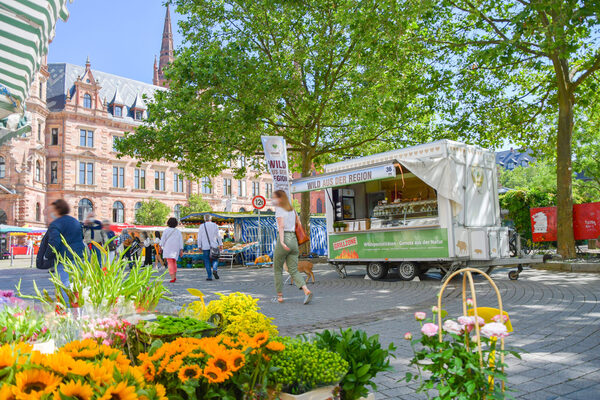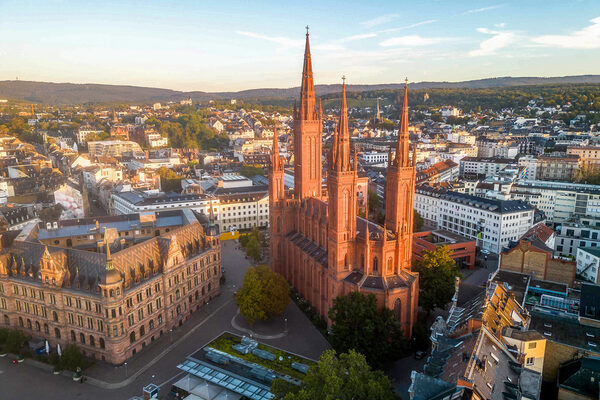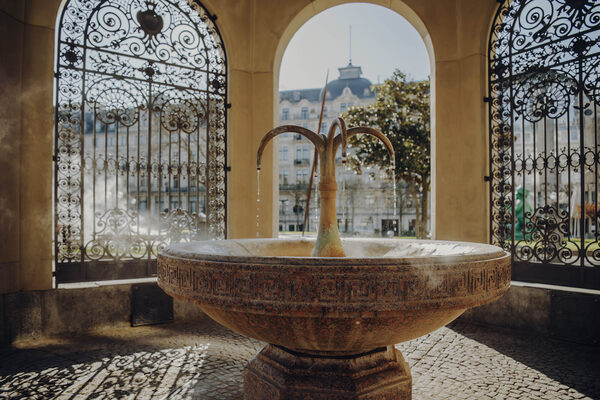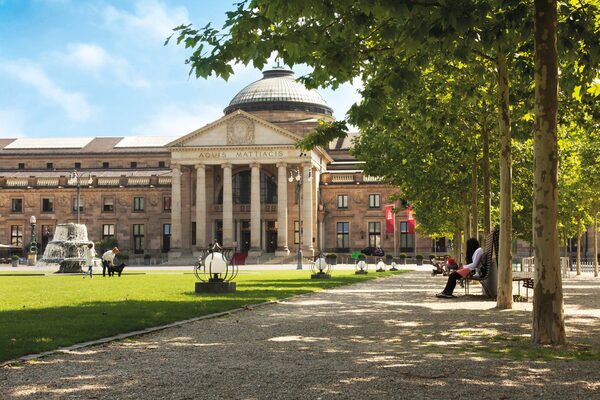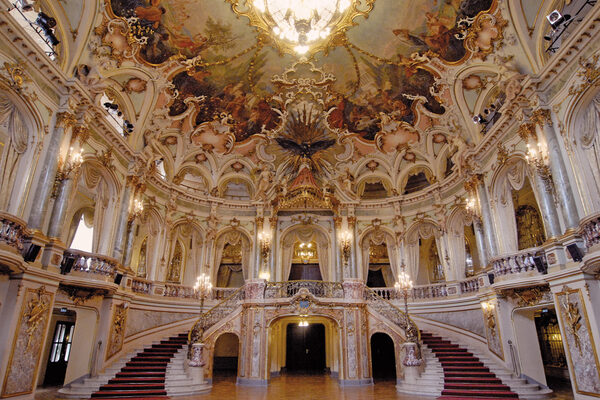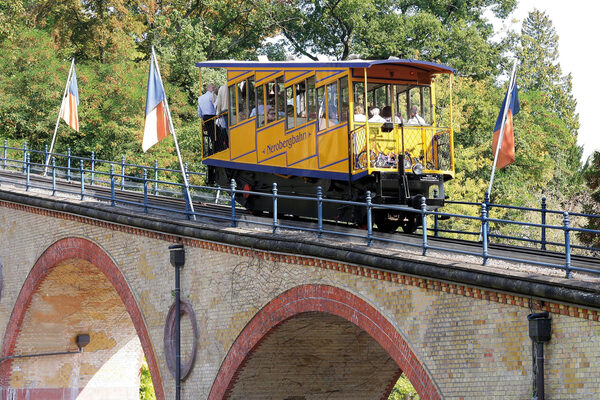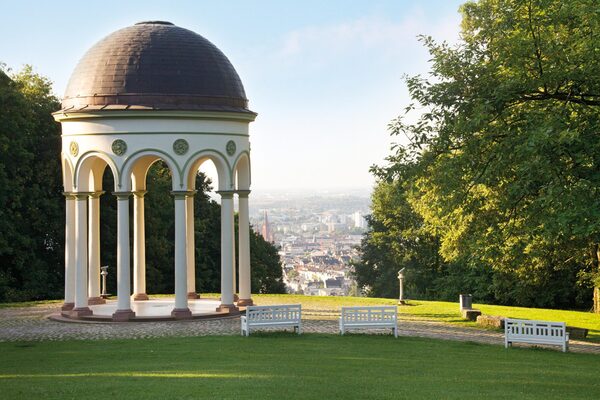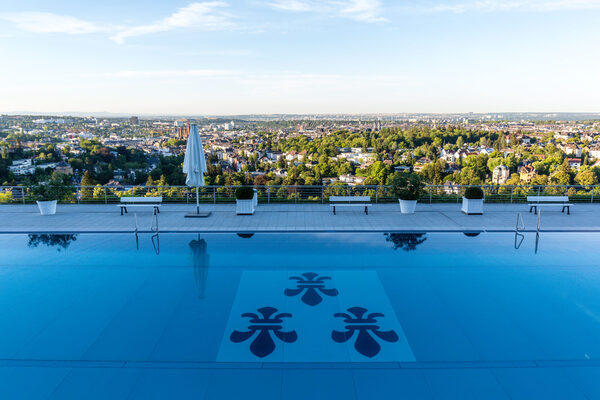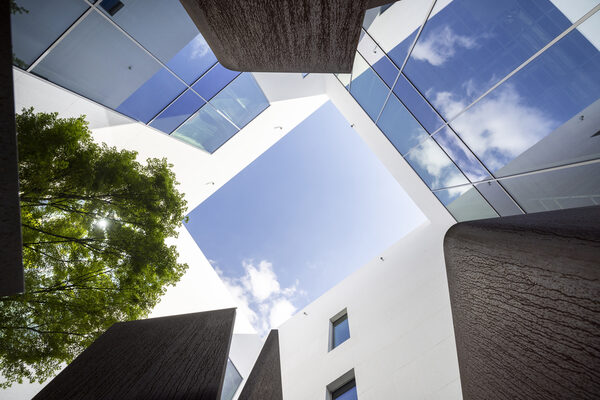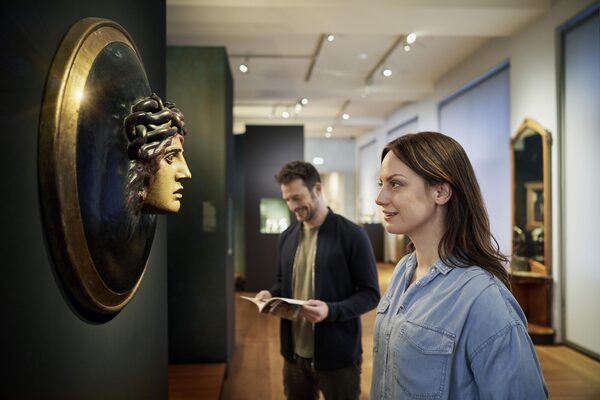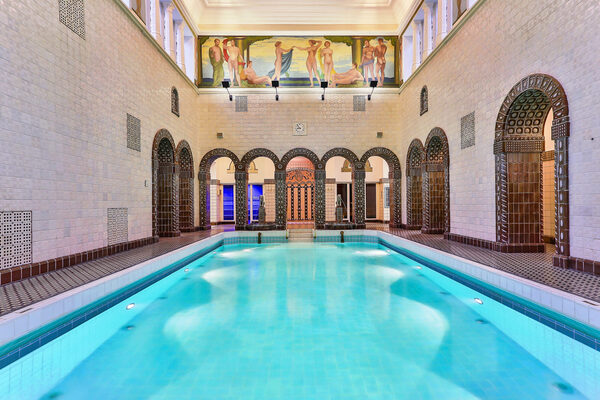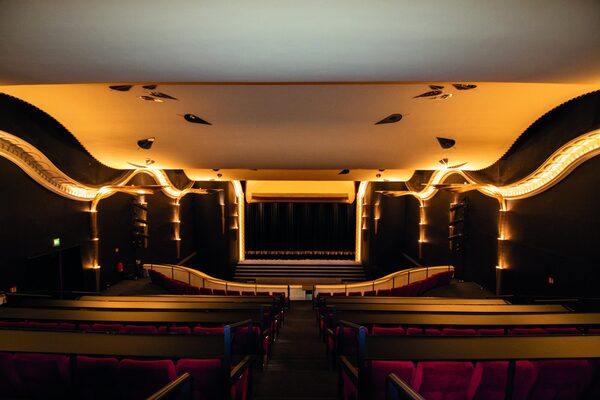You must have seen it
1. the weekly market
Strolling through the weekly market on the Dern'schen grounds on Saturday is a fixed ritual for many Wiesbadeners. Whether fruit, vegetables, eggs, cheese, baked goods, flowers or specialties from all over the world - you will find everything of the best quality here. Also to take away for a picnic. From April to November, different winegrowers serve their best wines at the wine stall every week. The nearby Mauergasse is a great place to relax with a coffee or glass of wine.
Market times:
Wednesdays and Saturdays from 7 am to 2 pm
Quellgeflüster tip: In Mauergasse, just around the corner from the market, there are numerous bars and cafés waiting for you to relax and "watch Wiesbaden" - such as the Italian bar sbagliato (opens in a new tab) or the wine bars of Laquai (opens in a new tab) and Balthasar Ress (opens in a new tab). A visit to the interior design store drinneN (opens in a new tab) is an absolute MUST!
2. the market church
With its towers made of bright red bricks, the Marktkirche is not only the tallest building in the Hessian state capital, but also an impressive example of 19th century neo-Gothic architecture. It was commissioned by Duke Adolf von Nassau and built between 1853 and 1862 and is often referred to as "Nassau's cathedral" due to its size and importance.
The organ, with over 6,000 pipes, is one of the largest instruments of its kind in Germany. The Marktkirche is known for its particularly good acoustics and great concerts.
Quellgeflüster tip: The Marktkirche's carillon, with its 49 bronze bells, can be played by hand, which is rare. That's why it's particularly worth listening to when the Market Church's cantors Thomas J. Frank or Hans Uwe Hielscher make the carillon ring on Saturdays at market time - from 12:05 to 12:30. Otherwise it can be heard daily at 9, 12, 15, 17 and 19 o'clock with changing melodies. On Shrove Tuesday, the carillon may also play the Narhallamarsch. Guided tours are also offered. Playing times, dates and samples can be found here (opens in a new tab)!
3. the cooking fountain
One of Wiesbaden's most impressive natural wonders bubbles up in the middle of the old town: the Kochbrunnen. One of Wiesbaden's 26 thermal and mineral springs rises to the surface here. Not only do clouds of steam rise from the round fountain basin - the water here comes straight from the depths at over 66 degrees Celsius! It smells slightly of sulphur and tastes ... takes some getting used to. But even the Romans knew: this spring has healing powers! You want to try it? Don't forget your cup!
4. the Kurhaus with casino & spa gardens
The Kurhaus is Wiesbaden's landmark. Opened in 1907, the magnificent building with its imposing columned façade and mighty dome sits enthroned on the edge of the Kurpark - a symbol of the elegant spa culture of the Belle Époque. Emperors, kings and artists were received here - from Kaiser Wilhelm II to Richard Wagner. Today, the Kurhaus hosts congresses, graduation ceremonies, balls and concerts. In addition to the foyer, there are beautiful rooms such as the Friedrich von Thiersch Hall and the Shell Hall.
Directly behind the Kurhaus is the extensive Kurpark in the style of an English landscape garden. Here, paths meander between old trees, well-tended flowerbeds and small ponds. How about a trip in a rowing boat across the spa park pond?
In December, a very special Christmas tree is set up in the foyer every year - a pyramid of 2,000 real poinsettias that bathe the room in a festive red.
Opening hours Kurpark:
May to September, daily from 5 a.m. to 11 p.m.
October to April, daily from 5 am to 8 pm
Opening hours for boat hire:
In the summer months and weather permitting:
Wednesdays to Fridays from 3 to 6 p.m.
Saturdays, Sundays and public holidays from 11 am to 6 pm
Quellgeflüster tip: The Kurhaus is also home to the Wiesbaden Casino (opens in a new tab), which was founded in 1810 and is one of the oldest and most beautiful in Europe. It is worth a visit for the beautiful rooms alone. Don't forget your identity card!
5. the Hessian State Theater Wiesbaden
The Hessisches Staatstheater Wiesbaden was commissioned by Kaiser Wilhelm II, who often visited Wiesbaden for a health cure and officially opened it in 1894. As a five-division house, it unites opera, ballet, drama, concerts and the Young State Theater under one roof. The highlight is the annual International May Festival, which brings artistic greats and top-class companies from all over the world to Wiesbaden.
Fun fact: Kaiser Wilhelm II was able to travel inside the theater by carriage. For this purpose, a so-called "Kaiserfahrt " was built under the foyer - a candle-lit path that allowed the Emperor to enter the theater in his carriage and go directly to his private box via the Kaisertreppenhaus.
6. the Nerobergbahn
The Nerobergbahn is a technical gem from the era of industrialization and Wiesbaden's "weirdest landmark". It has been taking passengers up the Neroberg in just three and a half minutes using water power since 1888. It is one of only four water-powered funiculars left in the world - and is still in its original condition.
How does it work? The two carriages are connected by a cable. The upper carriage is weighted down with up to 7,000 liters of water and pulls the lower carriage uphill under its own weight. No motor, no electricity - just the force of gravity and an ingenious design.
Riding times:
From April to the beginning of November
Mondays to Sundays: 9 am to 7 pm
7. the Neroberg
High above the rooftops of the city lies perhaps one of the most beautiful places in Wiesbaden: the Neroberg. From the Monopteros, a small round temple, you have a wonderful view over Wiesbaden - the Monopteros is the location for wedding photos! Nearby is the Russian Orthodox Church with its golden domes. Duke Adolf von Nassau had it built in the mid-19th century for his deceased wife - a monument to love and a touch of St. Petersburg in the middle of Wiesbaden.
The Neroberg has its own vineyard, which has been cultivated for 500 years and is one of the few inner-city vineyards in Germany.
Opening hours Russian Orthodox Church:
Weekdays from 10 to 16
Sundays from 9 a.m. to 4 p.m.
Quellgeflüster tip: Fancy a glass of wine with the most beautiful view over the vineyards and Wiebaden? Then head for the Chateau Néro (opens in a new tab) wine bar!
8. the Opelbad
And another highlight awaits on the Neroberg: the Opelbad! Located at an altitude of 245 meters, it is one of the highest outdoor pools in Hesse. It was opened in 1934, donated by Georg von Opel, a descendant of the famous automobile dynasty. His vision: a public pool in a prime location that refreshes body, mind and senses. To this day, nothing has changed - the Opelbad is considered one of the most beautiful open-air swimming pools in Germany.
9. mre - the Reinhard Ernst Museum
"In keeping with the city and at the same time something completely unique."
"Simple yet with a sophisticated interior design."
"Comfortable and uncompromisingly modern at the same time."
These were the ideas that museum founder Reinhard Ernst and his friend and star architect Fumihiko Maki had in mind when designing the museum, which has enriched Wiesbaden's cultural landscape since 2024. The unique museum building is dedicated to abstract art, making it one of the few museums in the world devoted exclusively to this theme.
On display are works from the international collection of founder Reinhard Ernst. Many of the artists in the collection are among the most important of the 20th and 21st centuries and have had a decisive influence on the central trends of abstraction.
Source whisper tip: As the architecture of the museum is so unusual, guided tours (opens in a new tab) on this topic are offered at the weekend. Of course, there are also guided tours (opens in a new tab) of the collection and the special exhibitions.
10 The Wiesbaden Museum
What today attracts visitors from all over the world as the Wiesbaden Museum began with a suggestion from Johann Wolfgang von Goethe. The prince of poets was a frequent visitor to Wiesbaden and was fascinated by the region's rocks. During a stay in 1815, he suggested systematically collecting the natural history treasures of the region - as the foundation stone for a museum. The first natural history collection was soon established and constantly expanded.
Today, the museum houses the two collection areas of art and nature. On the one hand, visitors can look forward to an important collection of classical-modern art, including works by famous expressionists such as Jawlensky. On the other hand, the natural history collection invites visitors on a journey through the history of the earth with taxidermied animals, fossils, minerals and interactive stations.
Not to be missed: The Art Nouveau collection, which is one of the most extensive in Germany with over 500 objects, and the butterfly collection by Johann Christian Gerning, which Goethe himself admired.
Quellgeflüster tip: On Long Thursdays (opens in a new tab), the museum is open until 9 pm and after-work tours, lectures and workshops are offered. There is reduced admission from 6 pm. On the first Saturday of the month, admission is free on Free Saturday (opens in a new tab)!
11. Kaiser-Friedrich-Therme
In the Kaiser-Friedrich-Therme you can travel back in time directly to the Romans. In the magnificent Art Nouveau baths, which were built in 1913, you can relax surrounded by mosaics, columns and artistic ceiling paintings (textile-free). A bathing area with Finnish sauna, steam bath, Roman-Irish sweat baths and relaxation rooms awaits you.
12th Caligari FilmStage
The Caligari FilmBühne on Marktplatz is a real gem among German cinemas - as none other than Oscar-winner Volker Schlöndorff called it. Opened in 1926 as the silent movie theater "Ufa im Park", a beautiful hall with red plush armchairs, brass swinging doors, a curved gallery and art deco lighting awaits you inside. The arthouse cinema presents selected film highlights as well as current productions.
Quellgeflüster tip: Once a month, the Caligari FilmBühne hosts a very special event: a silent film with live music (opens in a new tab)! A silent movie classic is shown, accompanied live by Uwe Oberg on the piano.
